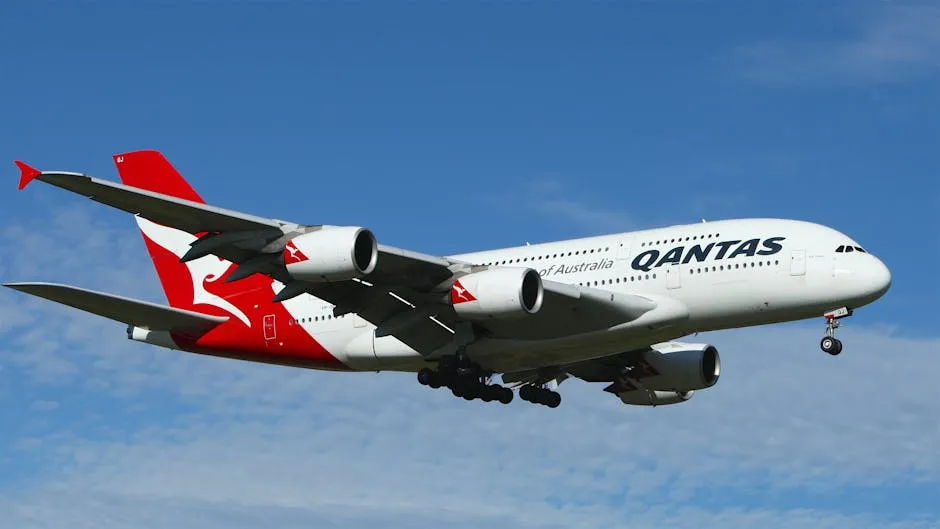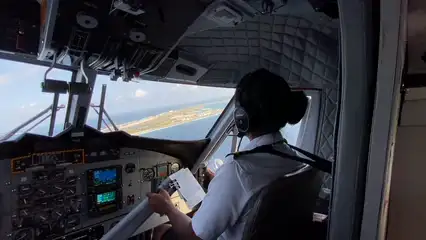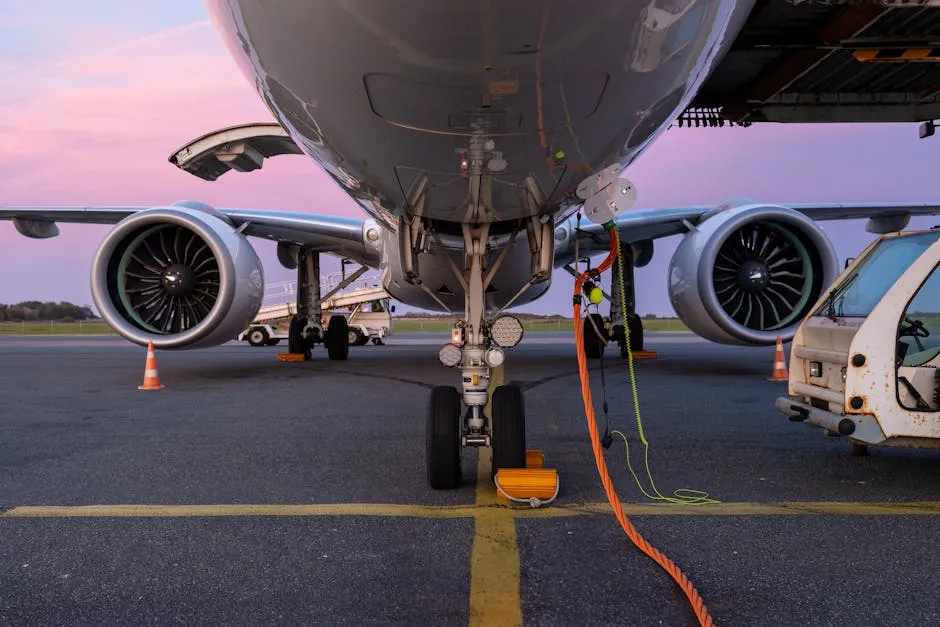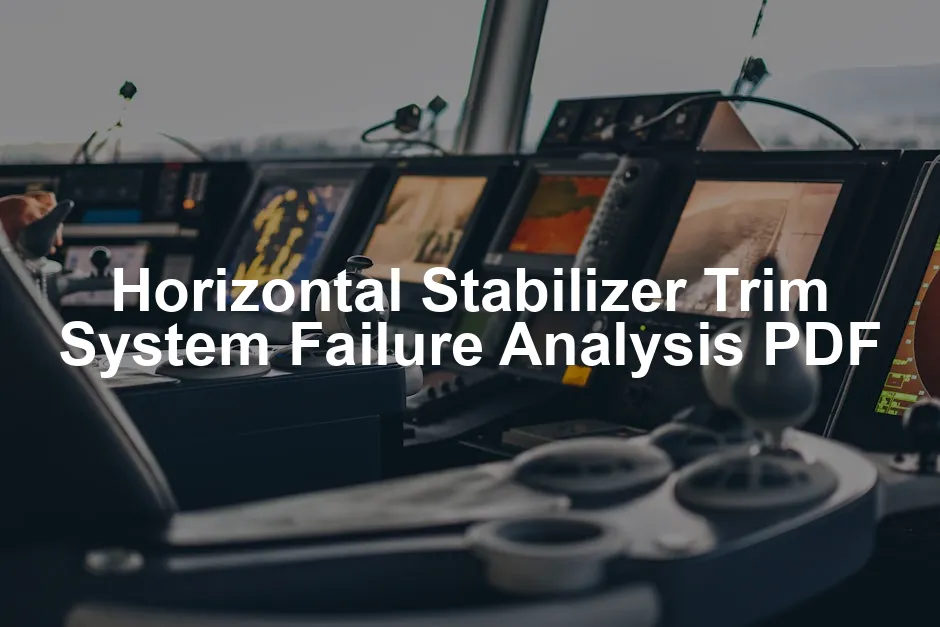Introduction
Horizontal stabilizer trim systems are crucial for aircraft control. They help pilots maintain stable flight by adjusting the angle of the stabilizer. Understanding how these systems fail is vital for enhancing safety. This article analyzes various failure modes and offers insights into improving system reliability. Speaking of which, if you’re looking to dive deeper into aviation safety, check out the Aviation Safety: A Balanced Industry Approach. It’s like a safety net for your brain!

Summary and Overview
Horizontal stabilizer trim systems play a key role in aircraft performance. They adjust the pitch attitude, ensuring smooth flight operations. Failure analysis methodologies include fault tree analysis and failure modes effects analysis. Understanding these methodologies helps identify potential failure points.
Failures in these systems can severely impact safety and performance. For example, an unresponsive trim system can lead to control difficulties. PDF documentation of failure analyses is essential for sharing findings across the aviation community, supporting continuous improvement in safety protocols. If you’re keen on the technical aspects, consider picking up the Aircraft Mechanic’s Handbook. Your guide to all things mechanical!

Understanding Horizontal Stabilizer Trim Systems
What is a Horizontal Stabilizer Trim System?
A horizontal stabilizer trim system adjusts the pitch of an aircraft. It helps maintain stable flight by changing the stabilizer’s angle. This system consists of several key components, including actuators, sensors, and control systems. If you’re curious about how to maintain these systems, check out the Aircraft Maintenance and Repair book for some solid insights!
Actuators move the stabilizer based on pilot inputs or automated commands. Sensors monitor the position and performance of these actuators, ensuring accurate adjustments. The control system interprets signals from the pilot and sensors to optimize stability during flight.
The importance of a trim system cannot be overstated. It enhances the aircraft’s control and reduces pilot workload. Without it, pilots would struggle to maintain level flight, especially during turbulent conditions. Want to take it to the next level? Grab a copy of The Pilot’s Handbook of Aeronautical Knowledge. It’s like having a co-pilot in your pocket!

Common Types of Trim Systems
Trim systems mainly fall into two categories: electromechanical and hydraulic designs. Electromechanical systems use electric motors for actuation. They offer precise control and often require less maintenance. However, they may be more sensitive to electrical failures. If you’re working on systems like these, a Multi-Tool for Aviation Mechanics could be your best friend!
Hydraulic trim systems utilize pressurized fluid to move the stabilizer. These systems are robust and can handle high loads but are heavier and require more maintenance.
Both types follow industry standards that ensure safety and reliability. Understanding these differences helps in selecting the right system for specific aircraft needs. Each design has its advantages and disadvantages, making it essential to choose wisely.

Failure Mechanisms in Trim Systems
Types of Failures
Trim systems can fail in various ways. Understanding these failures helps us enhance safety and reliability.
Mechanical failures are common. Actuator failures can prevent the stabilizer from moving. Linkage issues may cause improper adjustments. Both situations can lead to control difficulties during flight.
Electrical failures are another concern. Sensor malfunctions can disrupt system feedback. If control signals are lost, the trim system may not respond correctly. This can create dangerous flight conditions. To ensure you’re prepared, grab an Aviation Emergency Kit. Better safe than sorry!
Environmental factors also play a role. High temperatures can affect actuator performance. Humidity may lead to corrosion in electrical components. These conditions can reduce the overall reliability of the trim system.
Each failure type impacts system performance differently. Mechanical failures can lead to immediate control loss. Electrical failures may cause intermittent issues, complicating pilot responses. Environmental factors can cause gradual wear, often unnoticed until it’s too late. Recognizing these failure mechanisms is essential for effective maintenance and safety protocols.

Failure Detection and Monitoring
Detecting failures early is crucial for safety. Various techniques help monitor trim systems effectively.
Sensors are a primary tool for failure detection. They continuously track system performance. For example, linear variable differential transducers (LVDTs) measure actuator movement. If discrepancies arise, they signal potential issues. Want to enhance your understanding of aviation systems? Check out Aircraft Systems: Mechanical, Electrical, and Avionics Subsystems Integration.
Diagnostics play a significant role as well. They analyze sensor data, identifying patterns that indicate failure risks. Real-time monitoring systems provide immediate alerts, enhancing pilot awareness. This capability is vital for preventing accidents.
The importance of real-time monitoring cannot be overstated. It allows for timely interventions, reducing the severity of failures. Methodologies for analyzing failure data include fault tree analysis and statistical process control. These methods help identify root causes and trends, supporting continuous improvement in maintenance practices.
By implementing robust detection and monitoring systems, the aviation industry can significantly enhance safety. Timely detection of failures not only protects passengers but also prolongs the lifespan of aircraft systems.

Analysis of Failure Cases
Case Study: Alaska Airlines Flight 261
Alaska Airlines Flight 261 tragically crashed on January 31, 2000, claiming 88 lives. The crash was linked to a trim system failure, specifically the horizontal stabilizer trim actuator. This incident highlights the critical nature of the trim system, as it directly affects the aircraft’s stability during flight.
Investigators found that the actuator had experienced significant wear and tear, leading to a complete failure. The maintenance records indicated that the actuator was not properly serviced, raising questions about adherence to safety protocols. Contributing factors included a lack of redundancy in the trim system and insufficient training for maintenance personnel. These oversights created a perfect storm, ultimately leading to the accident.
From this incident, we learn that maintaining strict maintenance schedules is vital. Furthermore, implementing better training for technical staff can prevent similar failures. The need for redundancy in critical systems cannot be overstated. This case serves as a powerful reminder of the importance of rigorous safety practices in aviation. If you’re interested in the intricacies of flight safety, don’t miss out on Understanding Flight: Aircraft Design, Flight Safety, and Human Factors.

Other Notable Failures
Other notable incidents involving trim system failures also shed light on systemic issues. For example, a report on Comair Flight 5191 revealed similar actuator failures, which resulted from inadequate inspections and maintenance. These failures often stem from the same root causes: insufficient training, lack of proper monitoring, and failure to adhere to guidelines.
Common patterns emerge across these cases. Many incidents involve mechanical failures due to wear or misalignment. Electrical issues, such as sensor malfunctions, can also disrupt system performance. Environmental influences, like extreme temperatures or humidity, further complicate these failures. To manage these risks better, consider investing in Aviation Weather Radar. It’s a game changer!
Addressing these issues requires a systemic approach to failure analysis. Regular audits and updated training programs are essential to mitigate risks. An emphasis on proactive maintenance and comprehensive inspections can significantly improve safety outcomes. By learning from past failures, the aviation industry can foster a culture of continuous improvement, enhancing the reliability of trim systems and overall aircraft safety.

Best Practices for Failure Prevention
Design Considerations
To enhance the reliability of horizontal stabilizer trim systems, thoughtful design is essential. One effective strategy is incorporating redundancy in critical components. This means having backup systems in place, so if one fails, another can take over. For example, using dual actuators can ensure that control is maintained even if one actuator has issues.
Advanced materials and technologies also play a crucial role. Lightweight composites can reduce stress on components, while smart materials can adapt to changing conditions. These innovations help minimize failure rates by ensuring that parts can withstand various operational stresses. If you’re interested in the latest in aviation materials, take a look at Aircraft Engineering and Maintenance.
Incorporating rigorous testing during the design process is vital. Simulations can reveal potential weak points before they become real-world problems. By anticipating and addressing these issues early, manufacturers can create more resilient systems that stand the test of time.

Maintenance and Inspection
Regular maintenance and inspection are key to preventing trim system failures. Establishing a robust protocol ensures that all components are routinely checked. This includes inspecting actuators, sensors, and control systems for signs of wear or damage. For those who want to keep their aircraft in top shape, an Aircraft Cleaning Kit is essential!
Training personnel is critical. Maintenance teams should be well-versed in recognizing potential issues before they escalate. Regular workshops and updated training materials can help keep everyone informed about the latest best practices and technologies.
Documentation also plays a significant role in improving maintenance practices. Keeping detailed records of inspections and repairs can help identify trends over time. Analyzing this data can lead to continuous improvement, ensuring that safety protocols evolve with advancements in technology.

Conclusion
Understanding horizontal stabilizer trim system failures is vital for aviation safety. These failures can significantly impact both safety and operational efficiency. By focusing on prevention and rigorous analysis, we can enhance the reliability of these systems. Ongoing research and development in failure analysis methodologies are necessary to advance safety measures and technology in aviation. If you’re looking for a comprehensive guide, the The Art of Aircraft Maintenance is a must-read!

Please let us know what you think about our content by leaving a comment down below!
Thank you for reading till here 🙂
All images from Pexels




